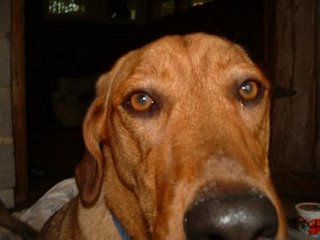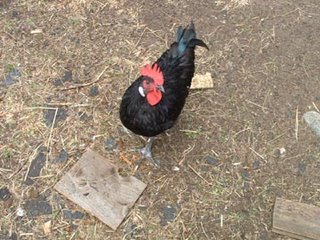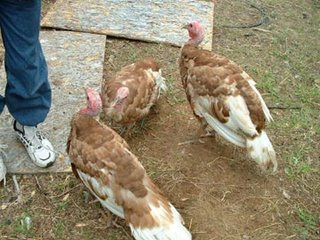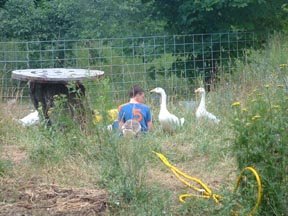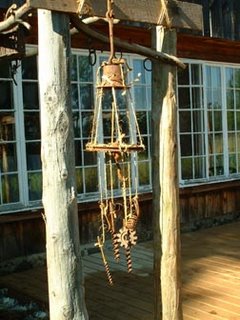a treatise on a rose bush
It’s raining outside, and instead of doing dishes and cleaning this place up a bit, I’m going to write about rose bushes. And life. My life, actually, or perhaps more about how a rose bush gave me a new way of looking at stuff that has happened in my life.
Just so you know, I use the word ‘perhaps’ a lot.
When we moved to the Drunken Goat, the back of the sauna was completely covered by the most amazing array of rose bushes I had ever seen. They were so big and high that they reached the roof of the sauna and were killing the pear tree that was near them. I really cut them back last fall, almost all the way to the ground. I found the grandmother rose bush then, the matriarch, the one that started it all. It was her branches that extended almost as high as the sauna and reached the pear tree. I felt a bit bad about cutting her back, but I felt worse about the potential of losing a pear tree.
This spring, she and her offspring came back, growing taller than I thought possible in a short amount of time. Not only were they growing taller, but it seemed as if the rose bush garden was extending itself farther and farther outward. There was new growth everywhere. I decided all but the grandmother had to go. They were too much, too big, too wild, too uncontrollable. They took up too much space. They just needed to go.
So I started to dig. I really wasn’t sure where to start. The branches of the roses were everywhere, and I couldn’t see much of anything, certainly not enough to determine where the roots were. But I started digging anyway. Didn’t hit any roots, but I sure tore my arms up. Big scratches as I fought the thorns, the sun and my salty sweat making my arms feel blistery burned. It took far too long and way too much blood before I began to realize that the smartest thing for me to do was to cut them all back with the hedge clippers so that I could at least see where to begin to dig. Duh.
Cutting back the branches wasn’t any less painful than trying to dig without being able to see. In fact, it was a bit more so. Not only were my arms still getting scratched up, but the thorns penetrated my work gloves as I pulled the branches from the compactness of the bushes and carted them to the fire pit. And it took a long time to get everything cleared out. When I was done, all that was left were the stubs of many rose bushes, some bigger than others, some just single stems. I could have stopped there, for now I could see that there was room for me to plant flowers in between all the bushes. Perhaps not as much space as would have been healthy for the plants when they grew, but they could probably have managed, at least for a while.
It was definitely a lot easier to see where to dig once everything was cut back. But as I dug, I began to realize this amazing thing: although I was digging up what I thought was one bush, if I followed the roots, they were actually many different rooted stems that only looked like they were a part of one bush. The roots went every which way, and it didn’t ever seem to make sense. I would have thought that the same root would have spread and started a new bush close to itself, but this was not the case at all. Sometimes the roots crisscrossed each other, sprouting new growth far away.
At first I would follow the root of one plant, digging up it’s offspring as I went, but that proved to be difficult. Other roots would be spread out on top of the one I was pulling up, and it was too physically difficult to pull them out. So I began to work in specific areas, pulling up all the roots from one section at a time. I stopped following the roots and concentrated on digging out the sections first, thus the roots began to be cut at the source. The farther along I went, the easier it became to pull out the rest of the roots.
I saved what I call the mother bush for last. The roots that came from the mother extending to the other bushes were pretty darn big. It was quite amazing. Here’s what I found to be most interesting, though. As I dug, I found 3 roots (why 3?) that went very deep into the ground. I dug at least 3 feet down to try to find out where they went, and I finally gave up. Perhaps this rosebush wasn’t the first offspring of the grandmother rose bush at all, but its own separate entity with no connections. But I’m not convinced. The size of the grandmother rose bush was much greater than this one, and the roots that extended from the grandmother were also much bigger, leading me to believe that the she had lived far longer than this particular bush. But who can really tell, anyway, other than the person who planted them many, many years ago? And I’ve no one to ask, as the memory has faded.
The metaphor:
Sometimes circumstances, usually painful ones, help us see the things and people in our lives that might be too wild, too uncontrollable, too painful, take up too much space, or are simply no longer serving our growth as they once did. Perhaps the painful situation has taken us back to our childhoods and has asked us to begin to dig up familial roots in order to examine why we have made and continue to make the kinds of choices that have caused us so much grief.
Often, when the circumstance presents itself, we know we need to do some digging. Perhaps we want to begin to dig for the roots quickly without being able to see where we are digging. We make ourselves bleed, over and over again until we either give up or get distracted. After all, our scratches need soothing, and it’s quite pleasant to accept the gentle and loving touch that makes us forget why we were digging in the first place. Distraction to pain, distraction to pain, distraction to pain. For some, the pain from each resulting distraction becomes intensely deeper, darker, more deadly. Some get lost here in this place.
Maybe as time goes on, if we are the lucky ones, we recognize that those distractions, as wonderful as they are in the moment, will ultimately lead us back to the pain that called us to dig in the first place. There is no fighting it, no rationalizing it away, no numbing it into oblivion. It is time, and it must be done. We start to dig, but we know that we can’t see what we are doing or where we are going. We need to do some cutting back. Some cutting off. It hurts. It makes us bleed. But for some, it’s the only way. The cutting off doesn’t solve our problems, for they are far deeper than that which has been cut, but it lets us see. It gives us distance, room to breathe, and although the scratches might still blister burn, we stop bleeding. Some, though, start planting without digging up the roots. They get lost in this place.
And so we begin the hard work of digging up roots. But we might find as we dig that the bushes we are attempting to dig up have many different roots. We don’t know where they are coming from or where they lead. What we think might be the root of one bush is actually the root of another. Maybe we follow the roots, or perhaps we just pick a section and start digging. It will probably take a long time, but if we continue, the roots become easier to see, and easier to pull out.
But like the mother rose bush, there may come a time when we realize that no matter how hard or deep we dig, we cannot pull the root. We have done all that we can do at the moment, and it’s time to let it go, put soil back in the deep hole we have dug, and begin to start sheet composting. It’s about damn time we started planting flowers!
